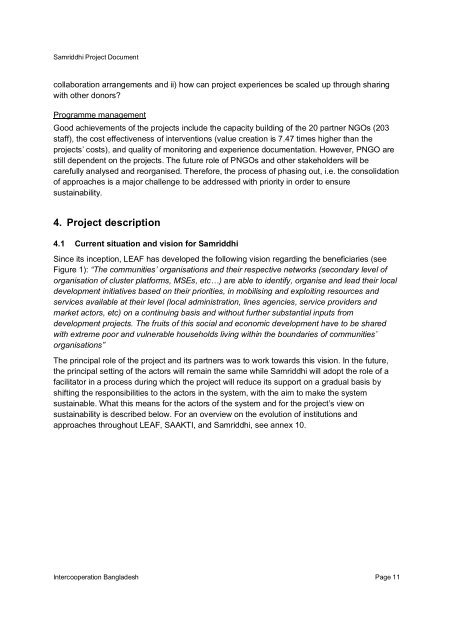Samriddhi
Samriddhi
Samriddhi
You also want an ePaper? Increase the reach of your titles
YUMPU automatically turns print PDFs into web optimized ePapers that Google loves.
<strong>Samriddhi</strong> Project Document<br />
collaboration arrangements and ii) how can project experiences be scaled up through sharing<br />
with other donors?<br />
Programme management<br />
Good achievements of the projects include the capacity building of the 20 partner NGOs (203<br />
staff), the cost effectiveness of interventions (value creation is 7.47 times higher than the<br />
projects’ costs), and quality of monitoring and experience documentation. However, PNGO are<br />
still dependent on the projects. The future role of PNGOs and other stakeholders will be<br />
carefully analysed and reorganised. Therefore, the process of phasing out, i.e. the consolidation<br />
of approaches is a major challenge to be addressed with priority in order to ensure<br />
sustainability.<br />
4. Project description<br />
4.1 Current situation and vision for <strong>Samriddhi</strong><br />
Since its inception, LEAF has developed the following vision regarding the beneficiaries (see<br />
Figure 1): “The communities’ organisations and their respective networks (secondary level of<br />
organisation of cluster platforms, MSEs, etc…) are able to identify, organise and lead their local<br />
development initiatives based on their priorities, in mobilising and exploiting resources and<br />
services available at their level (local administration, lines agencies, service providers and<br />
market actors, etc) on a continuing basis and without further substantial inputs from<br />
development projects. The fruits of this social and economic development have to be shared<br />
with extreme poor and vulnerable households living within the boundaries of communities’<br />
organisations”<br />
The principal role of the project and its partners was to work towards this vision. In the future,<br />
the principal setting of the actors will remain the same while <strong>Samriddhi</strong> will adopt the role of a<br />
facilitator in a process during which the project will reduce its support on a gradual basis by<br />
shifting the responsibilities to the actors in the system, with the aim to make the system<br />
sustainable. What this means for the actors of the system and for the project’s view on<br />
sustainability is described below. For an overview on the evolution of institutions and<br />
approaches throughout LEAF, SAAKTI, and <strong>Samriddhi</strong>, see annex 10.<br />
Intercooperation Bangladesh Page 11
















